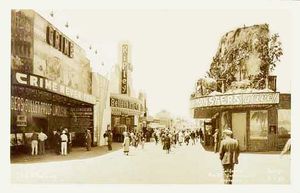The Panama-California Exposition
The Panama-California Exposition was an exposition held in San Diego, California between March 9, 1915 and January 1, 1917. The exposition celebrated the opening of the Panama Canal, and was meant to tout San Diego as the first US port of call for ships traveling north after passing through the canal. The fair was held in San Diego's large urban Balboa Park.
 Main article: World's Fair
Main article: World's Fair
Design
Colonel D.C. Collier, at the time often referred to as San Diego's greatest asset, was most responsible for the exposition's success. It was he who selected both the location of the city park and Spanish Mission and Pueblo style. Collier was tasked with steering the exposition in the proper direction, ensuring that every decision made reflected his vision of what the exposition will accomplish. Collier once stated "The purpose of the Panama-California Exposition is to illustrate the progress and possibility of the human race, not for the exposition only, but for a permanent contribution to the world's progress" (Christman 43).
New York architect Bertram Goodhue was chosen as supervisory architect. Goodhue advised use of the more varied Spanish Colonial architecture, and saw the exposition as an opportunity to create a fantasy city. The style employed at the Exposition was never common in San Diego before. Contrasting with bare walls, rich decoration would be used with influences from Mexican and Spanish architecture, including its Muslim and Persian nuances. The design was intentionally in contrast to most previous expositions, which had been done in Neoclassical style with large buildings around large symmetric spaces. This temporary decoration of the park was created with some large spaces and numerous paths, small spaces, and gardens. The location was also moved from a small hillock to a larger and more open area, most of which was intended to be reclaimed by the park as gardens.
Site
Cabrillo bridge ends at West Gate. Between the site of the exposition and the most readily reached edge of the park is Cabrillo Canyon. Cabrillo Bridge was built to span it, and its appearance of ending on the eastern end in a great pile of buildings would be the crux of the whole composition. This design and the bridge were intended to remain as a permanent focal point of the city.
The focus of the fair was the Plaza de California (California Quadrangle), an arcaded enclosure often containing Spanish dancers and singers, where both the approach bridge and El Prado terminate. The permanent California State and Fine Arts Buildings framed the plaza, which was surrounded on three sides by exhibition halls set behind an arcade on the lower story. Those three sides, following the heavy massiveness and crude simplicity of the Mission style, were without ornamentation. This contrasted with the frontispiece of the California State Building, wild with broken lines of moldings and crowded ornamentation. Next to the frontispiece, at one corner of the dome, rises the tower of the California Building which was echoed in the less permanent turrents of the Southern California counties, and the Science and Education Buildings. The style of the frontispiece is repeated around the fair.
There were three entrances to the site, on west, north, and east. The East Gateway was approached by drive and trolley car winding up from the city through the southern portion of the Park. From the west, the long bridge's entrance was marked with blooming giant century plants and led straight to the dramatic West Gate (or City Gate), which has the city's coat-of-arms at its crown. The archway is flanked by engaged Doric orders supporting a rich, fructated entablature enclosing, in the spandrels, beautiful figures symbolizing the Atlantic and Pacific oceans joining waters together in commemoration of the opening of the Panama Canal. These figures are the work of Furio Piccirilli. While the west gateway is part of the Fine Arts Building, the east gateway was designed to be the formal entrance for the California State Building. The East or State Gateway carries the state coat-of-arms over the arch. The spandrels over the arch are filled with glazed colored tile commemorating the 1769 arrival of Spain and the 1846 State Constitutional Convention at Monterey.
Transformation of a park
Intended to be permanent were the bridge, the domed-and-towered California State Building and the low-lying Fine Arts Building. The Botanical Building would protect heat-loving plants, while the Great Organ would assist open air concerts in its Auditorium. The architecture of the "temporary buildings" was recognized, as Goodhue described, as "being essentially of the fabric of a dream - not to endure but to produce a merely temporary effect. It should provide, after the fashion that stage scenery provides - illusion rather than reality."
Why is this article included on the SM-201 site?
While in the Navy, I visited, and was stationed at, San Diego. I used Balboa Park as a backdrop for many of my bondage photos <g>
External links
- "The Making of the Panama-California Exposition, 1909-1915", The Journal of San Diego History 36:1 (Winter 1990), by Richard W. Amero
- "The Southwest on Display at the Panama-California Exposition, 1915", The Journal of San Diego History 36:4 (Fall 1990), by Richard W. Amero
- Also see the page [ The Panama-California Exposition ] on Wikipedia
Main article and index is at World's Fair |

|
Chat rooms • What links here • Copyright info • Contact information • Category:Root
